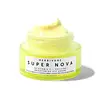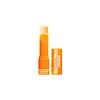What's inside
What's inside
 Key Ingredients
Key Ingredients

 Benefits
Benefits

 Concerns
Concerns

 Ingredients Side-by-side
Ingredients Side-by-side

Water
Skin ConditioningTetrahexyldecyl Ascorbate
AntioxidantButyrospermum Parkii Butter
Skin ConditioningTriheptanoin
Skin ConditioningBis-Diglyceryl Polyacyladipate-2
EmollientCoco-Caprylate/Caprate
EmollientPropanediol
SolventSimmondsia Chinensis Seed Oil
EmollientCetearyl Olivate
Sorbitan Olivate
EmulsifyingStearyl Stearate
EmollientPolyglyceryl-6 Stearate
EmollientGlycerin
HumectantSodium Stearoyl Glutamate
CleansingBehenyl Alcohol
EmollientCaffeine
Skin ConditioningGanoderma Lucidum Extract
Skin ProtectingCurcuma Longa Root Extract
MaskingAstragalus Membranaceus Root Extract
EmollientSpilanthes Acmella Flower/Leaf/Stem Extract
AntimicrobialHyaluronic Acid
HumectantUbiquinone
AntioxidantCarthamus Tinctorius Seed Oil
MaskingSclerotium Gum
Emulsion StabilisingC9-12 Alkane
SolventPolyglyceryl-6 Polyricinoleate
EmulsifyingSodium Levulinate
Skin ConditioningSodium Anisate
AntimicrobialMelia Azadirachta Flower Extract
Skin ConditioningPolyglyceryl-6 Behenate
Emulsion StabilisingMelia Azadirachta Leaf Extract
Skin ConditioningOcimum Sanctum Leaf Extract
Skin ConditioningSodium Phytate
Ocimum Basilicum Flower/Leaf Extract
TonicTocopheryl Acetate
AntioxidantCorallina Officinalis Extract
Skin ConditioningXanthan Gum
EmulsifyingBacillus Ferment
Skin ConditioningGlyceryl Caprylate
EmollientCitric Acid
BufferingWater, Tetrahexyldecyl Ascorbate, Butyrospermum Parkii Butter, Triheptanoin, Bis-Diglyceryl Polyacyladipate-2, Coco-Caprylate/Caprate, Propanediol, Simmondsia Chinensis Seed Oil, Cetearyl Olivate, Sorbitan Olivate, Stearyl Stearate, Polyglyceryl-6 Stearate, Glycerin, Sodium Stearoyl Glutamate, Behenyl Alcohol, Caffeine, Ganoderma Lucidum Extract, Curcuma Longa Root Extract, Astragalus Membranaceus Root Extract, Spilanthes Acmella Flower/Leaf/Stem Extract, Hyaluronic Acid, Ubiquinone, Carthamus Tinctorius Seed Oil, Sclerotium Gum, C9-12 Alkane, Polyglyceryl-6 Polyricinoleate, Sodium Levulinate, Sodium Anisate, Melia Azadirachta Flower Extract, Polyglyceryl-6 Behenate, Melia Azadirachta Leaf Extract, Ocimum Sanctum Leaf Extract, Sodium Phytate, Ocimum Basilicum Flower/Leaf Extract, Tocopheryl Acetate, Corallina Officinalis Extract, Xanthan Gum, Bacillus Ferment, Glyceryl Caprylate, Citric Acid
Squalane
EmollientWater
Skin ConditioningOryza Sativa Bran Wax
Skin ConditioningGlyceryl Stearate Se
EmulsifyingHelianthus Annuus Seed Wax
Skin ConditioningButyrospermum Parkii Butter
Skin Conditioning3-O-Ethyl Ascorbic Acid
Skin ConditioningHydrogenated Castor Oil
EmollientDiglycerin
HumectantBrassica Glycerides
EmollientCorylus Avellana Seed Oil
EmollientRicinus Communis Seed Oil
MaskingPolyglyceryl-4 Isostearate
EmulsifyingMica
Cosmetic ColorantCoco-Caprylate/Caprate
EmollientTetrahexyldecyl Ascorbate
AntioxidantMagnesium Ascorbyl Phosphate
AntioxidantLecithin
EmollientFragaria Vesca Seed Oil
EmollientAscorbyl Glucoside
AntioxidantGlycerin
HumectantPropanediol
SolventMagnesium PCA
HumectantCaffeine
Skin ConditioningC9-12 Alkane
SolventDisteardimonium Hectorite
StabilisingCaesalpinia Spinosa Gum
Skin ConditioningFerulic Acid
AntimicrobialRosa Damascena Flower Extract
MaskingRosa Centifolia Flower Extract
AstringentLimonene
PerfumingCaprylyl Glycol
EmollientPolyhydroxystearic Acid
EmulsifyingTremella Fuciformis Sporocarp Extract
AntioxidantTocopherol
AntioxidantSodium Hyaluronate
HumectantCyclodextrin
AbsorbentCitrus Limon Peel Extract
EmollientPanax Ginseng Root Extract
EmollientEthylhexylglycerin
Skin ConditioningTrisodium Ethylenediamine Disuccinate
Stearic Acid
CleansingSilica
AbrasiveTin Oxide
AbrasiveArnica Montana Flower Extract
MaskingAnanas Sativus Fruit Extract
Skin ConditioningCitral
PerfumingZingiber Officinale Root Extract
MaskingCitrus Tangerina Peel Extract
AstringentCitrus Aurantium Dulcis Peel Extract
Emulsion StabilisingCaprylic/Capric Triglyceride
MaskingLinalool
PerfumingVanilla Planifolia Fruit Extract
Skin ConditioningMentha Piperita Extract
CleansingGeraniol
PerfumingBis(Tripeptide-1) Copper Acetate
Skin ConditioningAcetyl Hexapeptide-8
HumectantSqualane, Water, Oryza Sativa Bran Wax, Glyceryl Stearate Se, Helianthus Annuus Seed Wax, Butyrospermum Parkii Butter, 3-O-Ethyl Ascorbic Acid, Hydrogenated Castor Oil, Diglycerin, Brassica Glycerides, Corylus Avellana Seed Oil, Ricinus Communis Seed Oil, Polyglyceryl-4 Isostearate, Mica, Coco-Caprylate/Caprate, Tetrahexyldecyl Ascorbate, Magnesium Ascorbyl Phosphate, Lecithin, Fragaria Vesca Seed Oil, Ascorbyl Glucoside, Glycerin, Propanediol, Magnesium PCA, Caffeine, C9-12 Alkane, Disteardimonium Hectorite, Caesalpinia Spinosa Gum, Ferulic Acid, Rosa Damascena Flower Extract, Rosa Centifolia Flower Extract, Limonene, Caprylyl Glycol, Polyhydroxystearic Acid, Tremella Fuciformis Sporocarp Extract, Tocopherol, Sodium Hyaluronate, Cyclodextrin, Citrus Limon Peel Extract, Panax Ginseng Root Extract, Ethylhexylglycerin, Trisodium Ethylenediamine Disuccinate, Stearic Acid, Silica, Tin Oxide, Arnica Montana Flower Extract, Ananas Sativus Fruit Extract, Citral, Zingiber Officinale Root Extract, Citrus Tangerina Peel Extract, Citrus Aurantium Dulcis Peel Extract, Caprylic/Capric Triglyceride, Linalool, Vanilla Planifolia Fruit Extract, Mentha Piperita Extract, Geraniol, Bis(Tripeptide-1) Copper Acetate, Acetyl Hexapeptide-8
Ingredients Explained
These ingredients are found in both products.
Ingredients higher up in an ingredient list are typically present in a larger amount.
This ingredient is also known as shea butter. It is an effective skin hydrator and emollient.
Emollients help soothe and soften your skin. It does this by creating a protective film on your skin. This barrier helps trap moisture and keeps your skin hydrated. Emollients may be effective at treating dry or itchy skin.
Shea butter is rich in antioxidants. Antioxidants help fight free-radicals, or molecules that may harm the body. It is also full of fatty acids including stearic acid and linoleic acid. These acids help replenish the skin and keep skin moisturized.
While Shea Butter has an SPF rating of about 3-4, it is not a sunscreen replacement.
Shea butter may not be fungal acne safe. We recommend speaking with a professional if you have any concerns.
Learn more about Butyrospermum Parkii ButterC9-12 Alkane is synethically created using alkanes, or paraffins. It is added to products as a solvent. This means its main purpose is to help dissolve ingredients and create even texture.
Caffeine is most associated with coffee, tea, and cacao. In skincare, it helps with calming inflammation and is rich in antioxidants.
While caffeine is used to treat cellulite and and dark circles, further studies are needed to prove this. It has been believed to help with these skin conditions due to its ability to dilate blood vessels and increase blood flow.
Some studies are looking into caffeine's ability to protect against UV rays.
Learn more about CaffeineCoco-Caprylate/Caprate is created from fatty coconut alcohol, caprylic acid, and capric acid.
It is a lightweight emollient. Emollients create a thin barrier on the skin to trap moisture in. This helps keep your skin hydrated and soft.
Once applied, Coco-Caprylate/Caprate is absorbed quickly and leaves a silky feel.
Coco-Caprylate/Caprate may not be fungal acne safe.
Learn more about Coco-Caprylate/CaprateGlycerin is already naturally found in your skin. It helps moisturize and protect your skin.
A study from 2016 found glycerin to be more effective as a humectant than AHAs and hyaluronic acid.
As a humectant, it helps the skin stay hydrated by pulling moisture to your skin. The low molecular weight of glycerin allows it to pull moisture into the deeper layers of your skin.
Hydrated skin improves your skin barrier; Your skin barrier helps protect against irritants and bacteria.
Glycerin has also been found to have antimicrobial and antiviral properties. Due to these properties, glycerin is often used in wound and burn treatments.
In cosmetics, glycerin is usually derived from plants such as soybean or palm. However, it can also be sourced from animals, such as tallow or animal fat.
This ingredient is organic, colorless, odorless, and non-toxic.
Glycerin is the name for this ingredient in American English. British English uses Glycerol/Glycerine.
Learn more about GlycerinPropanediol is an all-star ingredient. It softens, hydrates, and smooths the skin.
It’s often used to:
Propanediol is not likely to cause sensitivity and considered safe to use. It is derived from corn or petroleum with a clear color and no scent.
Learn more about PropanediolTetrahexyldecyl Ascorbate (THD) is a stable and oil-soluble form of Vitamin C.
THD is special in that it has the ability to travel deeper into skin than traditional ascorbic acid while maintaining the same skin benefits (double win!).
Because it’s oil-soluble, THD dives deep into your skin’s fatty layers (think ceramides and cholesterol) to fight off the kind of free radicals that mess with your skin barrier. This makes it a great pair with water-based vitamin C (ascorbic acid) that mainly works on the surface.
Even at just 0.1%, THD is already showing great antioxidant activity. When used up to 2%, it helps keep your skin happy and calm, especially when it’s stressed from pollution or sun.
Want to fade dark spots or tackle hyperpigmentation? You’ll want 5% or more. Pairing it with brightening buddies like niacinamide or licorice root gives even better results. One study even used 30% THD with other brighteners and saw real results on stubborn discoloration, even in melasma-prone skin.
A note on THD: It’s has a slightly silky, oily texture and usually shows up colorless or pale yellow (though the exact shade can vary by supplier).
While you can sneak it into water-based formulas, it really shines when paired with silicones or oils, which help your skin soak it up better.
THD is pretty stable, but it’s still vulnerable to degradation like ascorbic acid. Too much light or heat (above 113°F / 45°C) can break it down over time. Go for dark and opaque packaging that keeps it safe and shady!
Read more about other types of Vitamin C:
Learn more about Tetrahexyldecyl AscorbateWater. It's the most common cosmetic ingredient of all. You'll usually see it at the top of ingredient lists, meaning that it makes up the largest part of the product.
So why is it so popular? Water most often acts as a solvent - this means that it helps dissolve other ingredients into the formulation.
You'll also recognize water as that liquid we all need to stay alive. If you see this, drink a glass of water. Stay hydrated!
Learn more about Water